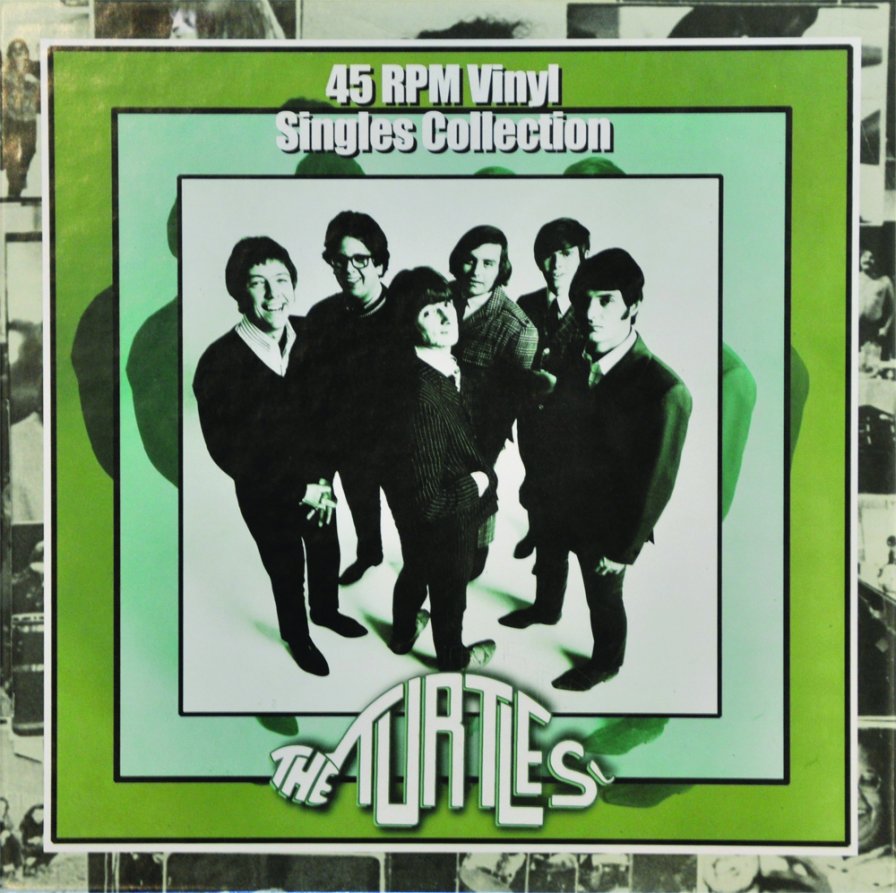I read a review of this box by another writer and the dude got stuck in the question of WHY? Why is this box set being released, who is it for, and what is the ultimate goal for its release? And normally I’d find those to be cogent questions, but in this case I found myself shifting from my initial thought upon receiving this, which was, “Hey, I fucking love The Turtles and haven’t spun that antique-shop LP in years, and now I won’t have to,” to, “Hey, he’s right, why the fuck are they releasing this?”
But isn’t that just another sign that reviewing has changed? I mean why the hell would I care who this box set is FOR? I’m not trying to ‘move units’ or encourage you to buy one thing and ignore another in my reviews. I write about music because I love it, and I’ve always had a soft spot for The Turtles, and… So what else the-fuck is there? And yes, there are no liner notes or little extras to help contextualize the ‘importance’ of this release; it’s pretty much a gaggle of 7-inches, made to order and ready to play. And you know what? That’s totally fuckin’ fine with me!
You might think Mrs. Rigby was the only famous rock n roll ‘Eleanor,’ but tweak the spelling a bit and you have one of my favorite anti-nuggets (as in not obscure enough to make it on the psych comps, yet not huge enough to show up on a lot of the ‘Best of the 60s’ bone-ups) of all-time, so sweet and affecting you forget the chords are so simple a baby could swipe through them. Then you have “Happy Together,” which soundtrack’d a Golden Grahams commercial at one point in the sad 80s but never even quite made The Turtles bona fide stars; from what I’ve been able to gather they were above The Mindbenders on the stardom scale but well below acts like The Hollies, which is a goddamn travesty (or at least a mini-tragedy) because I’ll put that tune up against just about anything hitting the charts around that time.
THOSE ARE THE SONGS YOU KNOW (plus that middling cover of “It Ain’t Me Babe” and the delightful “Guide for the Married Man,” perhaps?), but there’s a lot more to dive into here, particularly if you have an appetite for slightly sweet, un-psychedelic 60s rock with a twist of the sort of awkward lack of surety many of us experienced in our twenties. The Turtles’ stilted nature didn’t show up in their ‘hits,’ but it was exposed for all to see on a lot of these tunes, in particular “Sound Asleep,” a cut that features samples of a saw cutting wood, woodblock, and there are tips of the cap to “Tomorrow Never Knows” in the drums and the Indian instruments. Don’t get me started on the extended instrumental version…
From there I prefer to skip around a bit, as is my eternal wont in life in general. “You Showed Me” is the first Turtles song to chart and a lot of you will recognize its retro (even at the time), ‘safe’ feel, and almost shamefully innocent, Everly Brothers-esque harmonies from the radio if you have a decent oldies station in your town. “You Baby” rings of compromise with commercial gains in mind, and almost certainly influenced The Miracles’ “Love Machine.” One of my personal favorites despite its inherent corniness, “You Know What I Mean” is a fun, Association-style jaunt that puts forth a pleasant vibe without investing much in its drab aftertaste. “Love in the City,” for its total lack of chart love at its time of release, holds up just fine and is another example of how The Turtles managed to sound great without ever adhering to a specific ‘sound,’ jumping around wildly from track to track.
As occurs so often in life, the deeper you dig the more you get your hands dirty. “Grim Reaper of Love” pushes more of that young-guy confusion up front in the form of pained choruses and a strangely swinging constitution. This is about as trippy as the Turtles got, and it’s a rather dazzling side of the band I hadn’t experienced. “The Story of Rock and Roll,” on the other hand, despite being penned by Harry Nilsson, is just flat-out bad, in case you couldn’t tell from the title (and that’s a real thing; if you can’t tell a song sucks from its title you have no business discussing music in any public forum), one step below the rung of “Cover of the Rolling Stone” on the ladder of empty, self-congratulatory rock bluster.
And so on and so forth; by the second paragraph you knew if you wanted this or not so why do I rant so? Then again, I’ve only covered about half of the tracks on this set, so there’s a lot more nosing around to do. It’s like an everything-you-ever-wanted-to-know-about-The-Turtles-but-were-afraid-to-ask kind of thing, except you were never truly afraid of asking, just overwhelmed by the thrust of today’s fast-moving music machine. I say, take the time to disconnect from the streams, premieres, and glamor-shot publicity photos and dive into some more of the rock n roll that birthed this ridiculous culture in the first place.
More about: The Turtles
